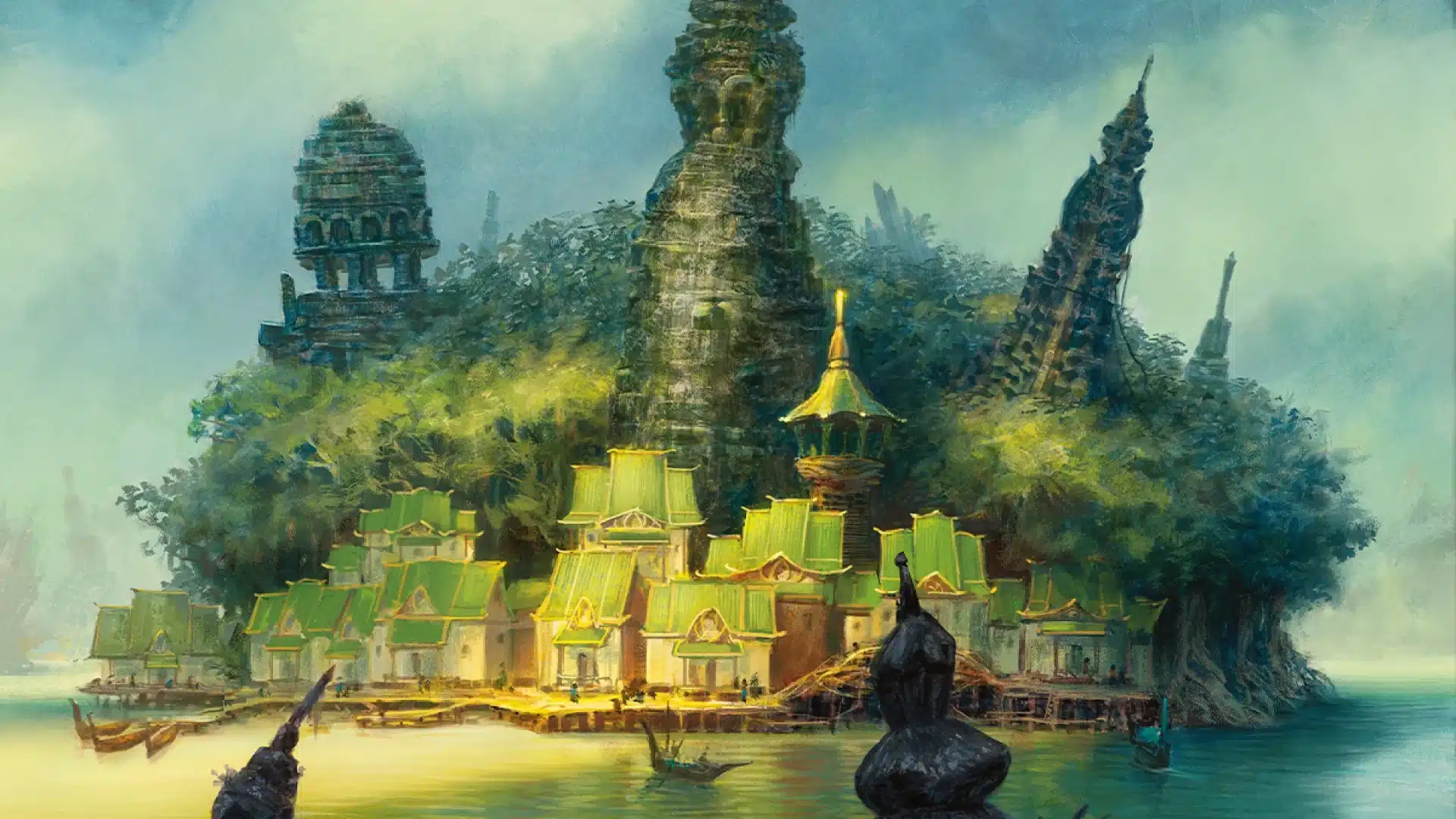As we near the end of week one of Tarkir: Dragonstorm previews, Wizards isn’t letting up the pace one bit. We’ve seen a ton of spicy Magic: The Gathering cards over the last few days, including a Dragon-making board wipe and a cheap infinite combo engine. Today, the hype train continues down the track. A brand-new rare land cycle has just been revealed for Tarkir: Dragonstorm, and it’s looking very tasty indeed.
While these aren’t three-color lands, as you’d probably expect from Tarkir, they do play nicely in three-color decks. They also have surprising echoes of the utility land cycle from Modern Horizons 3, which has proven itself useful in multiple formats. Whether you play Standard, Commander, or even older formats, these new lands are well worth keeping an eye on.
The Tarkir: Dragonstorm Rare Land Cycle
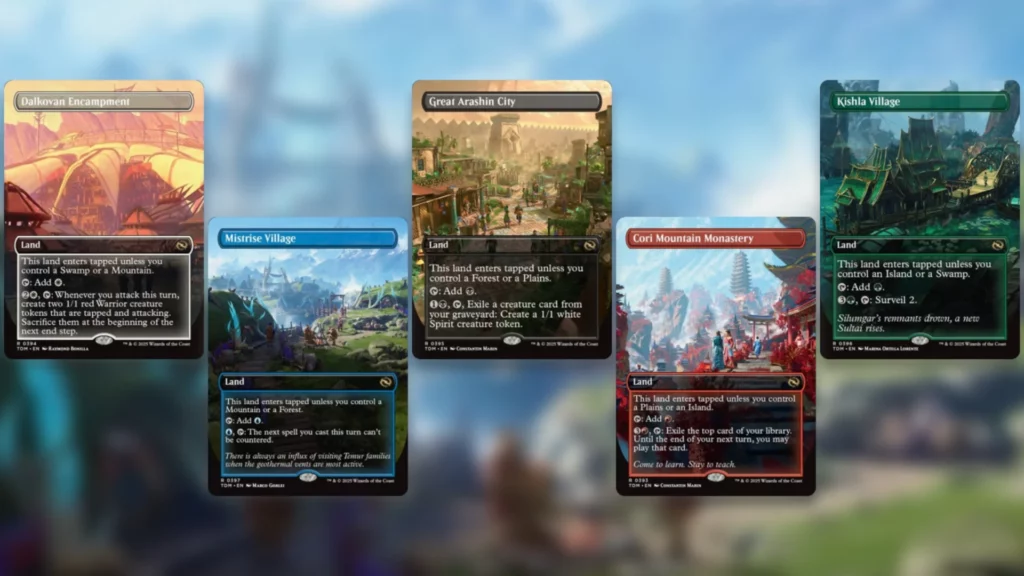
All of the new lands in this cycle tap for a single color of mana and enter tapped if you don’t control one of two other land types. Each, naturally, represents one of the three-color Clan wedges of Tarkir. Dalkovan Encampment is the Mardu land, for example, and it taps for white and requires a Swamp or Mountain to enter untapped. This means these lands are ideal in three-color decks that fit a Tarkir wedge exactly, but they can also play just fine in two-color decks.
This enter-untapped condition is very similar to the cycle of utility lands from Modern Horizons 3, Shifting Woodland et al. In fact, it’s probably better in most situations. Unless you’re running a Mono-Color deck, gaining access to an extra color by having a first or second in play is often more useful. With how many excellent three-color legendary creatures there are these days, I expect a lot of decks to find slots for these over Basics.
Interestingly, since the abilities on these lands only use the color of mana the land taps for, all of these lands have a Mono-Color identity. This makes them incredibly flexible in Commander. You don’t need to be playing a Mardu deck to run Dalkovan Encampment, for example; Boros, Orzhov, and even plain ol’ Mono-White can all run it too.
Dalkovan Encampment
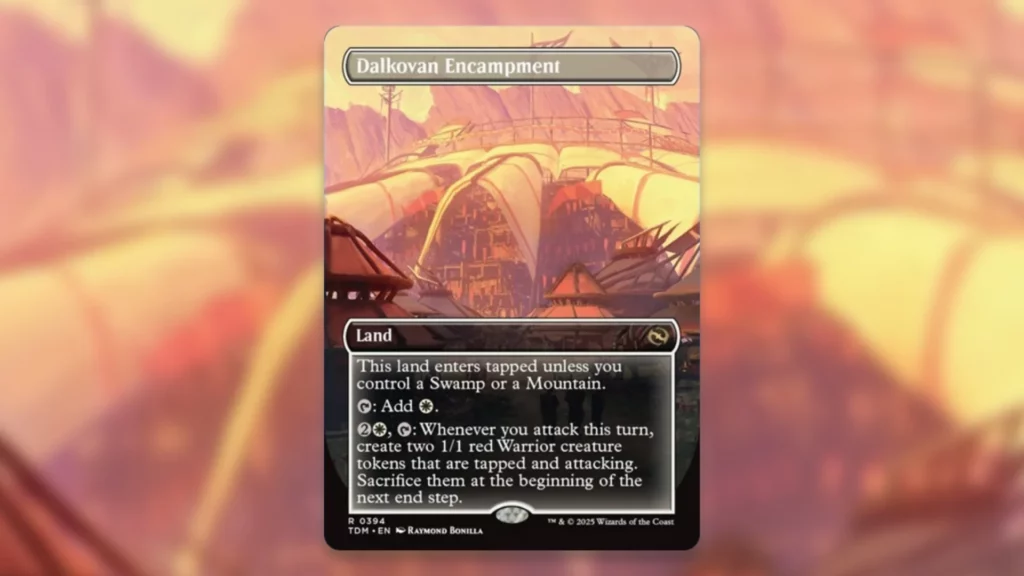
- Rarity: Rare
- Type: Land
- Card Text: This land enters tapped unless you control a Swamp or a Mountain.
Tap: Add W.
2W, Tap: Whenever you attack this turn, create two 1/1 red Warrior creature tokens that are tapped and attacking. Sacrifice them at the beginning of the next end step.
Speaking of Dalkovan Encampment, I do think it’s one of the best cards in the cycle. Four mana (counting tapping the Encampment itself) for two 1/1 tokens isn’t a great rate, but the fact that they get to attack right away is excellent. This makes the card great for Aggro decks stuck in long, drawn-out games.
In terms of where it slots in right now, both Boros Convoke and Mono-White Token Control have fallen out of favor in Standard of late. This card may help bring them back into prominence, however, thanks to the extra consistency it offers. It may also find a home in the up-and-coming Orzhov Sacrifice decks in the format.
In Commander, there’s little reason not to play this over a Plains in any Boros or Orzhov deck. Some aggressive Mono-White lists will probably pick it up too, and it’ll be a white Aristocrats staple until the end of time.
Mistrise Village
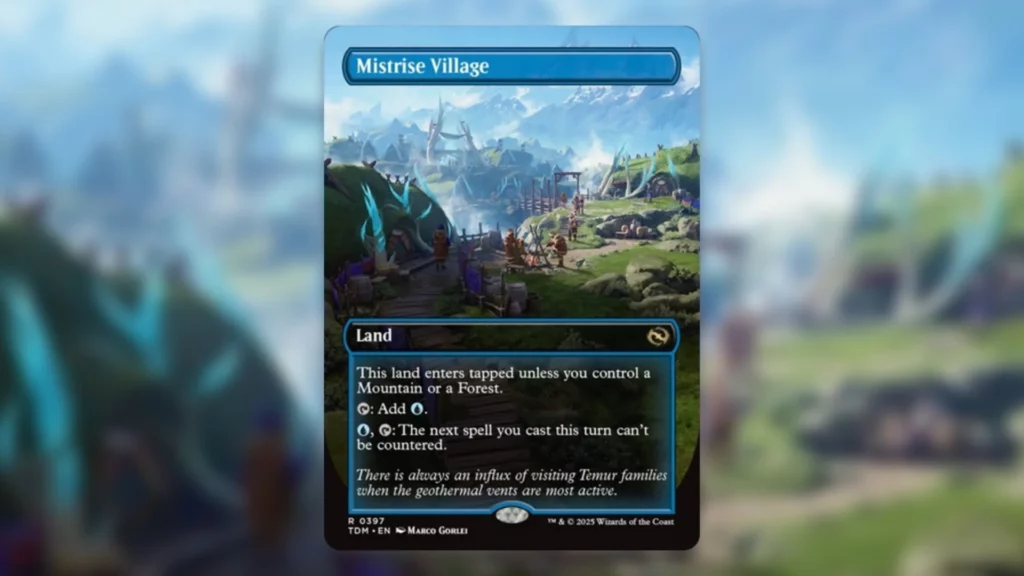
- Rarity: Rare
- Type: Land
- Card Text: This land enters tapped unless you control a Mountain or a Forest.
Tap: Add U.
U, Tap: The next spell you cast this turn can’t be countered.
Mistrise Village is, by most players’ reckoning, the best card in the Tarkir: Dragonstorm rare land cycle by far. There are already threads discussing the card in the Modern, Legacy, and cEDH communities on Reddit, which tends to be a surefire sign of quality.
Making any spell you cast uncounterable for just a two mana investment is a much bigger deal than it sounds. Cavern of Souls is a beloved card in older formats, as are the likes of Delighted Halfling and Allosaurus Shepherd. Basically, the further back you go in Magic: The Gathering, the better the countermagic gets, and the better cards that stop it get in turn.
Mistrise Village lets you sneak through any spell you want, which will make all sorts of combos easier to pull off. Stopping activated abilities on lands is pretty much impossible, too, so there’s not much your blue-playing opponents can do once it’s in play. On top of all that it produces blue itself: probably the best color in older MTG formats. If this isn’t a pricey staple a few weeks from now, I’ll be very surprised.
Great Arashin City
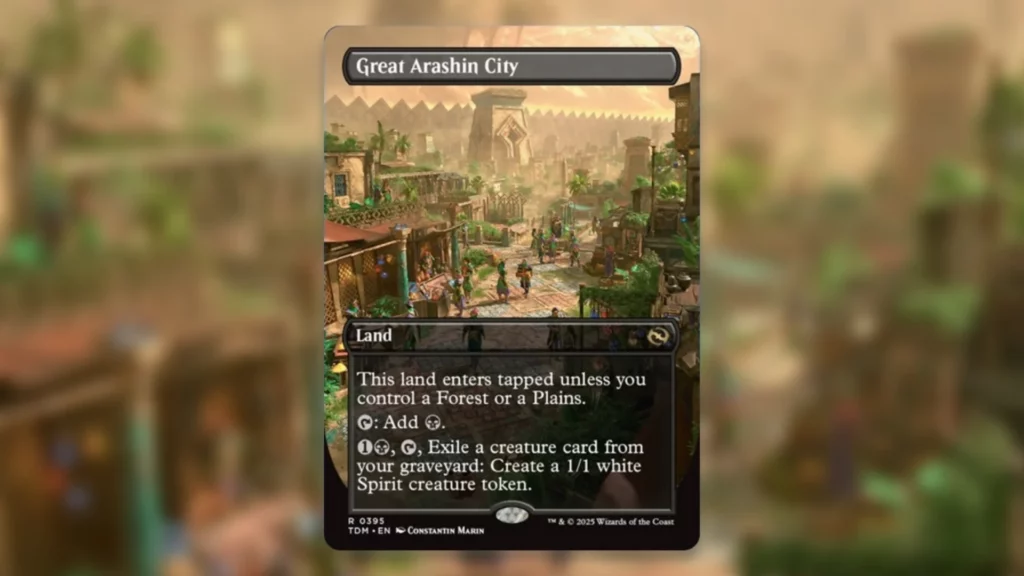
- Rarity: Rare
- Type: Land
- Card Text: This land enters tapped unless you control a Forest or a Plains.
Tap: Add B.
1B, Tap, Exile a creature card from your graveyard: Create a 1/1 white Spirit creature token.
After those first two, there’s a marked drop in quality for the rest of the Tarkir: Dragonstorm rare land cycle. That’s not to say these are bad cards, far from it. Just that the abilities of these last three are a bit underwhelming when compared to the first two, Mistrise in particular.
Great Arashin City does have one of the cheaper activated abilities in the cycle, but the fact that it asks you to chip away at your own graveyard isn’t great. Most black decks these days do something with the graveyard, and that something tends to be better than this. There’s probably an argument for this in Standard Orzhov Sacrifice, but you actively weaken your core Raise the Past strategy if you use it.
Outside of Standard, this will probably see sparing Commander play, but it’s very unexciting. Unless your deck specifically cares about Spirits, there are better utility lands and duals than this.
Cori Mountain Monastery
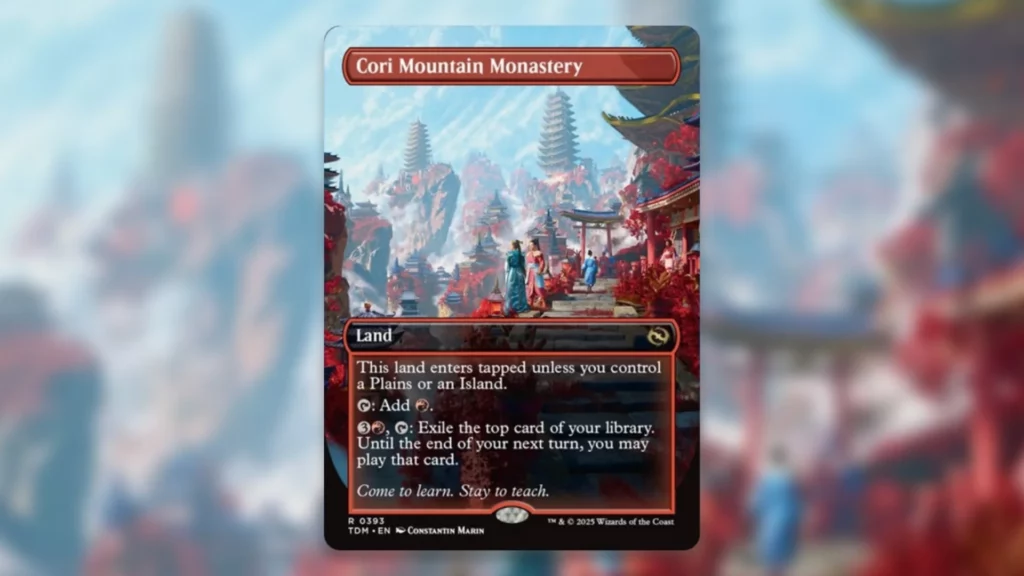
- Rarity: Rare
- Type: Land
- Card Text: This land enters tapped unless you control a Plains or an Island.
Tap: Add R.
3R, Tap: Exile the top card of your library. Until the end of your next turn, you may play that card.
While Cori Mountain Monastery’s activated ability is very expensive, I actually think it has a lot of potential. This is the Jeskai wedge land, which means you’ll be pairing it with blue, white, or both. In both Izzet and Azorius decks, holding up mana on your opponent’s turn is very common, since it lets you interact with anything they might do. With Monastery out, you have the option to just Impulse draw a card if no other interaction is needed, which is very nice indeed.
Since the card can be played until the end of your next turn, activating this ability on your opponent’s turn is actually the best time to do it. There’s a chance you hit an instant with immediate relevance, and if not you get to untap before the card disappears, so your chances of casting it go way up.
Current Standard Aggro is pretty much all Gruul and Mono-Red, so I don’t expect Monastery to see play there. Nice as it is, Aggro really doesn’t want to be running tapped lands. In Commander, this should be a red super-staple, since card draw on lands is fantastic in the format. Even if you’re not playing a reactive, Control-style deck, this is an easy inclusion.
Kishla Village
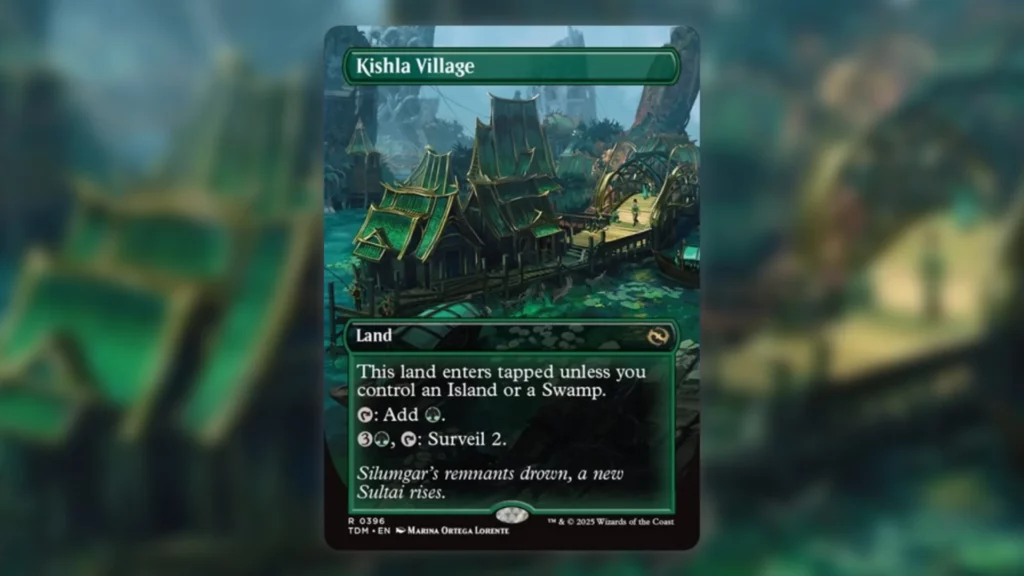
- Rarity: Rare
- Type: Land
- Card Text: This land enters tapped unless you control an Island or a Swamp.
Tap: Add G.
3G, Tap: Surveil 2.
The last card in the Tarkir: Dragonstorm rare land cycle may be the most middle of the road of all of them. Kishla Village lets you Surveil 2 for five mana, which is a pretty abysmal rate. You don’t generate card advantage with this ability, yet it costs the same amount as Monastery’s. That said, there are enough synergies that this enables that I think it might see play regardless.
In current Standard, Golgari Self-Mill decks have been doing pretty well of late. A land like this, which provides self-mill and/or card selection on a generally untapped green source, is a great addition to those lists. It’s not exciting in the slightest, but any decks like this will probably run a couple of copies over basic Forests.
In Commander, green graveyard decks are wildly popular. Whether it’s Karador, Muldrotha, Meren, or even Slimefoot and Squee, there’s no shortage of lists that want to pack their graveyard with goodies. While it’s nowhere near the level of Shifting Woodland, I expect Kishla Village to see play in pretty much all the same decks. Inefficient as the ability is, it’s still worth running this in any deck where it can enter untapped.
